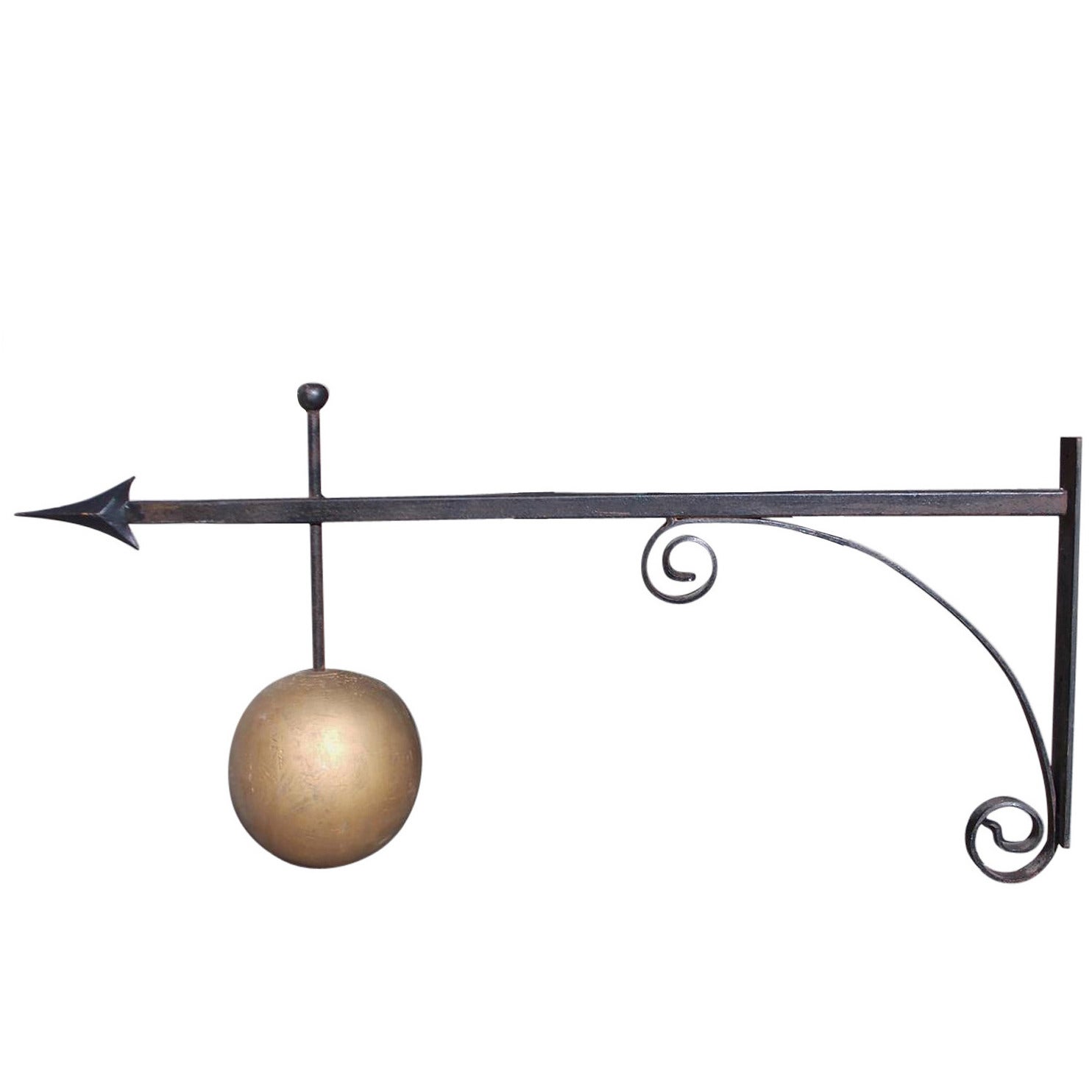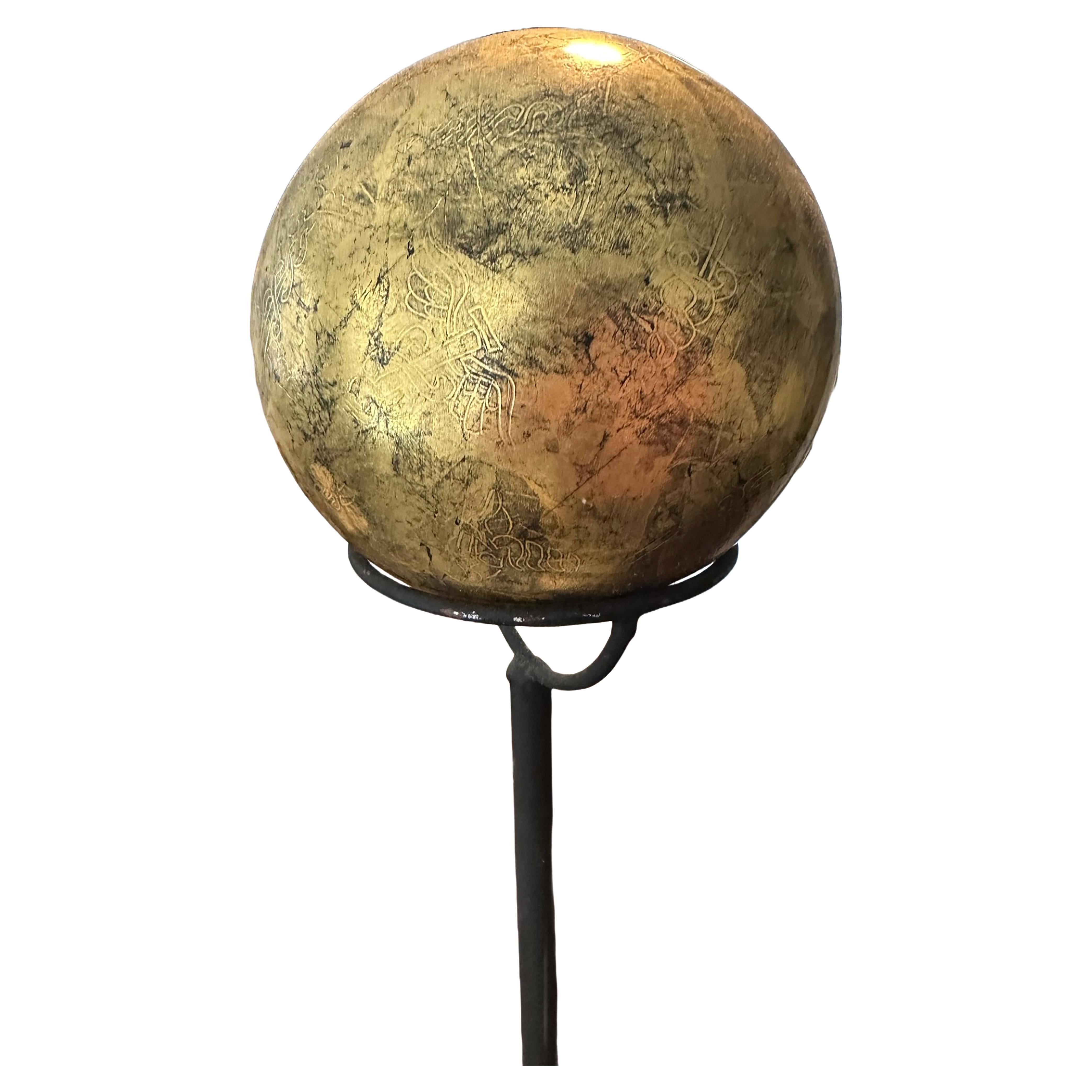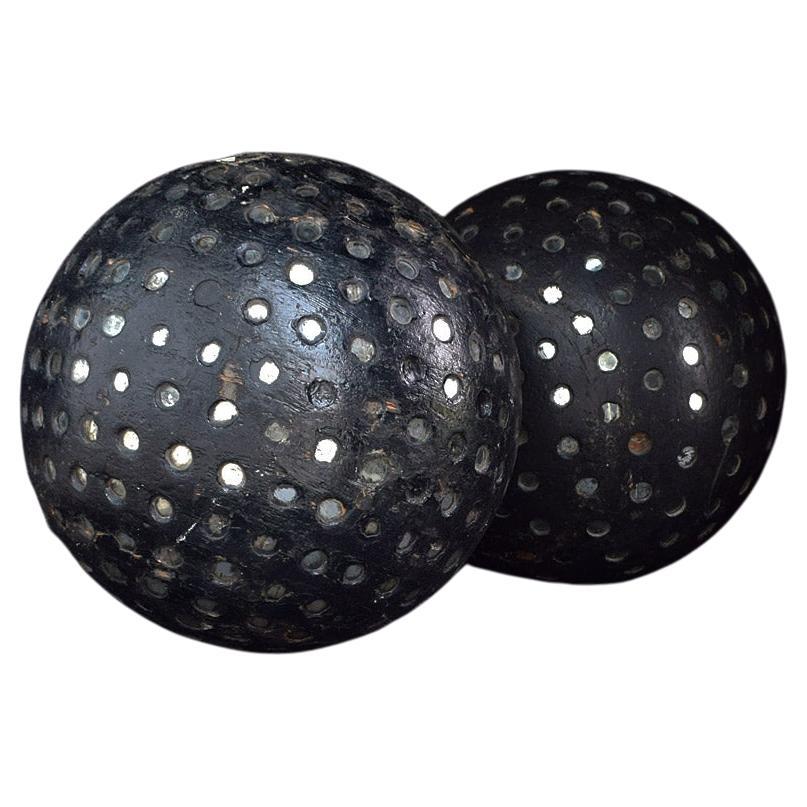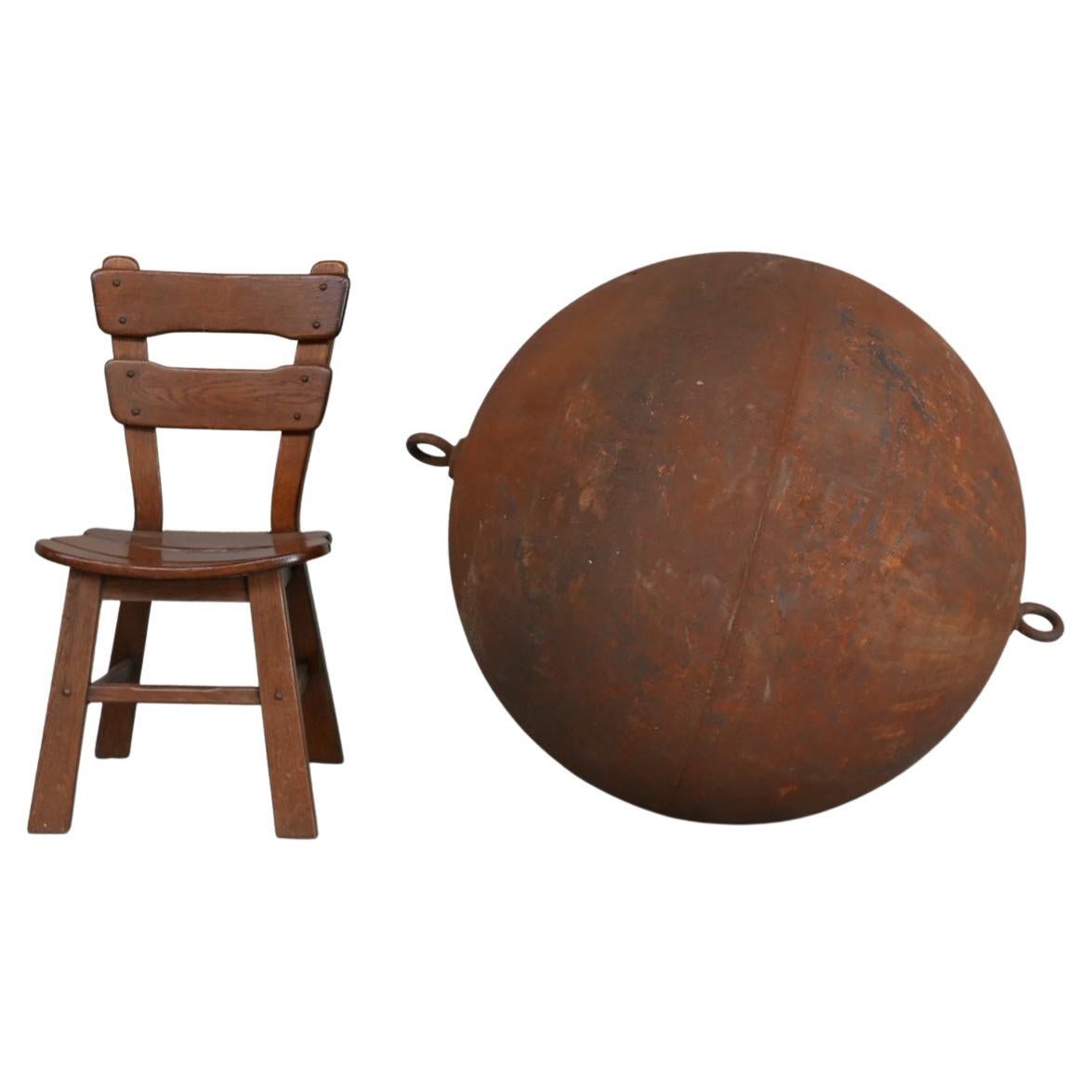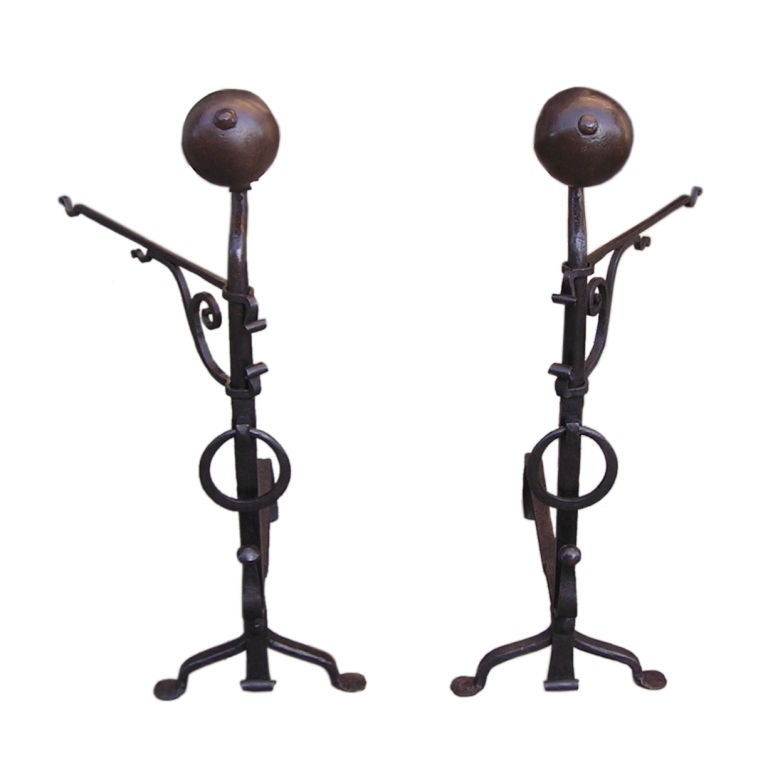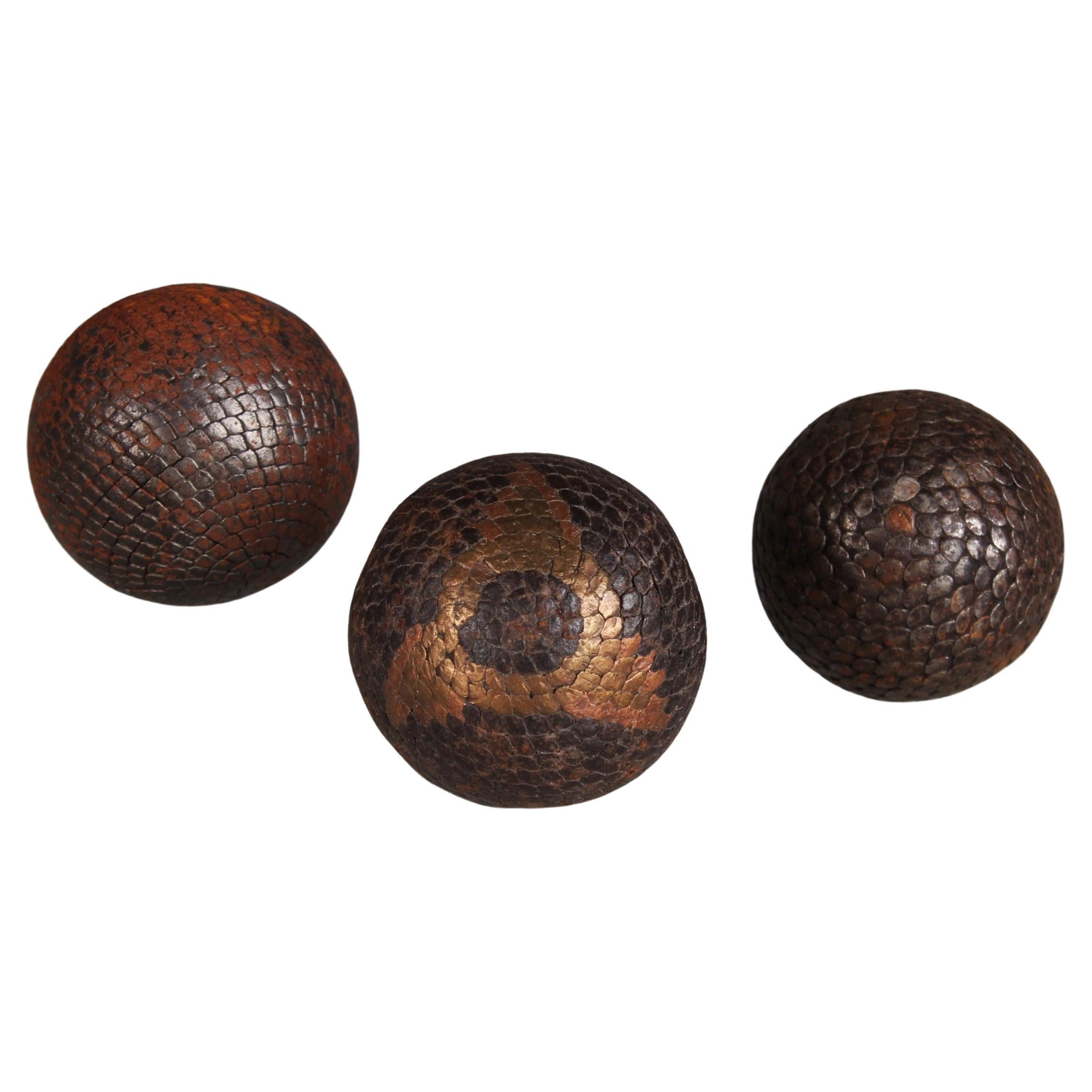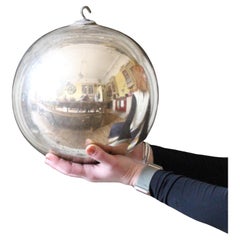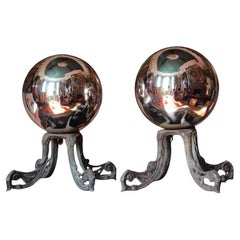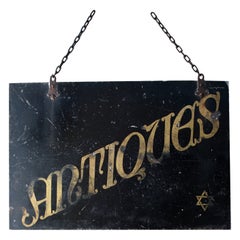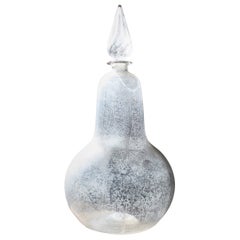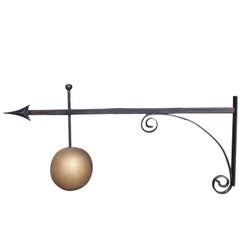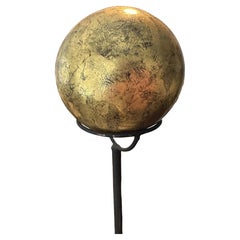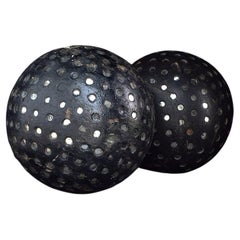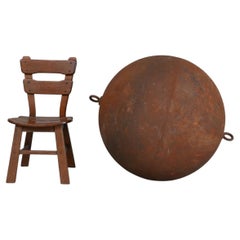Items Similar to Impressive Huge 19th Century Pawnbroker Folk Art Sign with Three Spheres Symbol
Want more images or videos?
Request additional images or videos from the seller
1 of 15
Impressive Huge 19th Century Pawnbroker Folk Art Sign with Three Spheres Symbol
$6,187.56
£4,495
€5,284.27
CA$8,559.46
A$9,433.12
CHF 4,938.55
MX$115,868.49
NOK 62,053.95
SEK 58,077.56
DKK 39,454.56
About the Item
An impressive rare and monumental in scale folk art pawnbroker trade sign with its original trio of giltwood spheres which represent the universal symbol for the pawnbroker trade.
Each sphere is suspended by a wrought iron inserted hook, they also retain there original oil gilt finish with age related wear knocks and abrasions totally untouched and original.
The decorative wrought iron bracket also has its original green painted finish.
Mid 19th century in age, English in origins
116cm in depth (of bracket)
51cm in width
71cm in height
Two balls are 31cm in diameter, the third one is 39cm in diameter
108cm approx in drop when balls are in situ
- Dimensions:Height: 27.96 in (71 cm)Width: 20.08 in (51 cm)Depth: 45.67 in (116 cm)
- Style:Victorian (Of the Period)
- Materials and Techniques:
- Place of Origin:
- Period:
- Date of Manufacture:circa 1840
- Condition:Wear consistent with age and use. Minor structural damages.
- Seller Location:Lowestoft, GB
- Reference Number:1stDibs: LU4612139005482
About the Seller
5.0
Gold Seller
Premium sellers maintaining a 4.3+ rating and 24-hour response times
Established in 2013
1stDibs seller since 2019
200 sales on 1stDibs
Typical response time: <1 hour
- ShippingRetrieving quote...Shipping from: Lowestoft, United Kingdom
- Return Policy
Authenticity Guarantee
In the unlikely event there’s an issue with an item’s authenticity, contact us within 1 year for a full refund. DetailsMoney-Back Guarantee
If your item is not as described, is damaged in transit, or does not arrive, contact us within 7 days for a full refund. Details24-Hour Cancellation
You have a 24-hour grace period in which to reconsider your purchase, with no questions asked.Vetted Professional Sellers
Our world-class sellers must adhere to strict standards for service and quality, maintaining the integrity of our listings.Price-Match Guarantee
If you find that a seller listed the same item for a lower price elsewhere, we’ll match it.Trusted Global Delivery
Our best-in-class carrier network provides specialized shipping options worldwide, including custom delivery.More From This Seller
View AllEarly 20th Century Large Foxed Mercury Mirror Witches Hanging Ball Curio
Located in Lowestoft, GB
A larger than the normal witches mercury mirror ball, with a beautiful time worn oxidisation to the interior. Thick hand blown glass with a simple steel hanging hoop, turn off the ce...
Category
Early 20th Century English Scientific Instruments
Materials
Blown Glass
Early 20th Century Pair of Mirror Witches Balls on Bronze Stands
Located in Lowestoft, GB
A matching pair of early 20th century mirrored witches balls, with pressed steel galleries and hanging hoops. They have later been associated to a pair of extremely well cast and he...
Category
Early 20th Century English Scientific Instruments
Materials
Bronze
Antique Early 20th C Hanging Trade Shop Sign "Antiques" Star of David Solomon
Located in Lowestoft, GB
Hanging double sided trade sign, sheet metal with a black ground and gilt lettering. Two pretty cast iron riveted hanging brackets.
A small Star of Solomon is located in the corner ...
Category
Early 20th Century English Signs
Materials
Metal
19th Century Large Apothecary Chemist Carboy Pharmacy Shop Trade Sign
Located in Lowestoft, GB
A 19th century hand blown glass chemist window display carboy. Used as a symbol of the pharmacy from the 17th century to the early 20th century.
A rare example with a hollow cut ...
Category
Antique Mid-19th Century English Signs
Materials
Blown Glass
1930's Huge Industrial Foxed & Pitted Convex Railway Mirror
Located in Lowestoft, GB
A huge convex mirror, used on the European railways in the 1930/40s
With a life spent out in the elements its acquired the most wonderful pitting and oxidation to the mirror plate,...
Category
Mid-20th Century European Convex Mirrors
Materials
Steel
18th Century, Carved & Gilt Wall Sconces Lion Paw, Human Fist Ship Flag Mount
Located in Lowestoft, GB
An early pair of oversized converted wall sconces on the form of a lions paw and a males fist, late 18th century in age
We believe these hard wood carvings would off been an elaborate wall mount for the a flag, likely bearing a ships flag...
Category
Antique Late 18th Century European Wall Lights and Sconces
Materials
Hardwood, Giltwood
You May Also Like
American Wrought Iron and Gilt Trade Sign Bracket , Circa 1880
Located in Charleston, SC
American wrought iron and gilt trade sign bracket with decorative scroll work and gilt ball motif. Late 19th Century
Category
Antique 1880s American Folk Art Signs
Gilt Wood Sphere Sculpture "Medicine Ball" by Michael Stallings with Stand
Located in Dallas, TX
An exquisite water gilt wooden sphere sculpture titled “Medicine Ball” by American artist Michael Stallings. This piece was created as a part of the artists ‘Visual Pun series. Creat...
Category
Early 2000s American Sculptures and Carvings
Materials
Giltwood
Early 20th Century, Circus Balancing Balls
Located in London, GB
Early 20th century circus balancing balls.
We share what we love, and we love these rare early 20th century hand crafted wood and glass mirror English circus balancing balls. Each section is hand crafted using pins...
Category
Vintage 1920s British Folk Art Sculptures and Carvings
Materials
Mirror, Wood
Huge Unusual Metal Ball Buoy Curio
Located in London, GB
A huge metre wide metal circular ball likely to be a buoy or the like.
Hard to age but likely France, c1920s.
Great condition with an amazing patina.
Each end has a hangi...
Category
Mid-20th Century French Garden Ornaments
Materials
Metal
Pair of American Wrought Iron Ball Top Andirons with Penny Feet. Circa 1780
Located in Charleston, SC
Pair of American wrought iron ball top andirons with rear swinging cranes, centered rings , spit hooks , and resting on scrolled legs with penny feet. 1...
Category
Antique 1780s American American Colonial Andirons
Materials
Wrought Iron
Antique Boule Balls Set "B", Pétanque, 1880s, France, Craftsmanship
Located in Greven, DE
Beautiful, unique Boule set of three Boule balls, France, late 19th Century.
In the 19th century, the manufacture of boules balls underwent significant development in France as the game of boules, particularly the pétanque variant, gained in popularity. The manufacture of boules balls during this period was a manual process that required expertise, precision and love to detail.
In the late 19th and early 20th centuries, particularly in rural areas of France and other Mediterranean regions, olive wood was a commonly used source of material for making boules balls. This was not only due to the availability of the material, but also to the outstanding properties of olive wood, which was characterized by hardness, strength and a rich grain.
First, the olive wood was carefully selected and shaped into raw balls, which were then sanded to the desired size and shape. The nails were then hammered into the balls one by one, making sure that they were evenly distributed and firmly anchored. Finally, the spheres were polished and coated with a protective varnish to enhance their natural beauty and protect them from the elements.
The use of nails to decorate and reinforce olive wood boules was a traditional practice that not only gave the ball a rustic aesthetic, but also improved its durability and contributed to customization. Many balls were made according to the specific requirements and preferences of the players. Nails were driven at regular intervals around the ball, with each nail hole precisely placed so as not to affect the balance and weight distribution of the ball. These nails not only served as a decorative element, but also helped to strengthen the structure of the ball and make it more resistant to the hard knocks and wear and tear during play. Individual engravings or decorations were often applied to the balls to make them unique and identify the player.
Antique boules...
Category
Antique Late 19th Century French Late Victorian Antiquities
Materials
Olive
More Ways To Browse
Antique Sphere
Iron Sphere
Antique Iron Brackets
Wrought Iron Sphere
Antique Business Signs
Antique Pub Sign
Porcelain Advertising Sign
Vintage Letter M Sign
Blacksmith Sign
California Highway Signs
Light Up Signs
Saloon Bar
Soda Advertising
Tin Advertising Signs
Trade Sign Zinc
Vintage Road Signs
Antique Restaurant Signs
Antique Wood Advertising Sign
